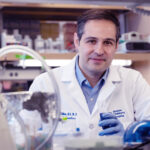Ava’s journey with arrhythmogenic cardiomyopathy

Claire Poole never thought a 10-year-old could have a heart condition. So when her daughter, Ava, slumped against the wall exhausted and complaining of arm pain one Sunday in 2012, Claire assumed she had overextended herself at a sleepover the previous night.
“When we got into the car, Ava turned grey and had trouble breathing,” says Claire, “But I still didn’t realize what was going on. I called her primary care doctor thinking she had developed pneumonia from a flu she had a week before.”
Arrhythmogenic cardiomyopathy at age 10
But Ava’s situation was much more dire. Despite her age, Ava was indeed having cardiac inflammation leading to chest pain and difficulty breathing. What no one suspected at that stage is that Ava had a rare form of inherited heart disease, called arrhythmogenic cardiomyopathy (ACM), a condition that can lead to heart inflammation, life-threatening heart rhythm disturbances, and sudden death.
By the time they arrived at Ava’s doctor’s office that day, all of Ava’s symptoms had resolved, so they sent her home to rest. Six hours later, she started feeling sick again. And when she complained of further pain in her chest, Claire drove her to their local emergency room on Cape Cod. There, they did an EKG, which was normal. But when a blood test identified Ava’s troponin levels were elevated, a sign of cardiac inflammation, she was immediately transfered to Boston Children’s Hospital.

First diagnosis: Myocarditis
Because Ava had recently had the flu, the doctors thought it was myocarditis, an infection leading to inflammation of the heart. “They put her on bedrest for a few weeks and she seemed to recover fine,” says Claire
In fact, all seemed well for a year and a half. Then in July 2014, Ava had a second, very similar episode.
“I had soccer practice that day, and when I got home, I could feel something was wrong,” says Ava. “My chest hurt, but I thought maybe my sports bra had been too tight. I went to bed thinking it would go away, but I woke up at 3 a.m. in even worse pain.”
Ava woke her mother, who immediately drove her to the hospital. The doctors found Ava’s troponin levels were elevated again and sent her right to Boston Children’s.
That’s when Dr. Dominic Abrams, cardiologist and director of the Inherited Cardiac Arrhythmia Program, became more involved in Ava’s care. Although ACM does not often present in children, Dr. Abrams thought Ava’s recurrent symptoms were very suggestive of this type of genetic cardiomyopathy.
While Ava spent five days resting in the hospital, Dr. Abrams ran a series of tests, including a cardiac MRI. The MRI showed inflammation of the heart muscle in a pattern consistent with ACM, and a subsequent genetic test identified a specific change associated with ACM that supported Dr. Abrams’ suspicions.

All in the family
Because ACM runs in families, Dr. Abrams suggested Claire and Ava’s father both get clinical and genetic testing, as well. “We submitted the tests, and it turns out I have the same genetic marker for ACM as Ava, and yet I’ve never had any symptoms,” says Claire. “That’s what makes this disease so interesting. We look so much alike and have the same marker, but present so differently.”
A heart monitor, then an ICD
Since there is no cure for ACM, the next step was to determine if she was experiencing any heart rhythm disturbances.
After initial testing, Dr. Abrams decided to implant a small heart monitor which records the heart rate and rhythm continuously. Over several years, it showed an increase in the amount of ventricular ectopic beats (one of the heart rhythm abnormalities associated with ACM) she was experiencing. Additionally, as Ava’s heart function was beginning to deteriorate, Dr. Abrams felt it was appropriate to implant a cardioverter-defibrillator (ICD), which detects and treats life-threatening heart rhythm disorders.
A shock to the heart
Three months after the ICD was implanted, Ava received a shock from it.
“I could feel a twitch as it tried to pace my heart out of the arrhythmia. Then a second after that it went off,” says Ava. “First, I felt one of my shoulders hunch, then I felt it very strong in lower back, like getting kicked by horse. I screamed, ‘Ow,’ just as the feeling passed. I was left with a tingling in my shoulder blade.”
Ava, sat down, drank some water, and then called her mom. “I had been very worried about what the ICD would feel like when it went off, but when it happened I knew exactly what it was,” she says.
Claire drove her to Boston Children’s, where she was monitored overnight. “Once it was determined what caused the ICD to deliver a shock and that the ICD had done its job, they sent me home,” says Ava.

Learning to live with ACM
Since that time, the device has not gone off again. Now 17, Ava says that knowing the ICD is working to protect her heart if she has an arrhythmia is a big comfort, and allows her to live a mostly normal life. That’s not to say she hasn’t had to make some lifestyle changes since being diagnosed with arrhythmogenic cardiomyopathy.
As she tours colleges, she’s also aware of keeping her condition in mind. “I need to ask about their medical facilities and think about how hilly the campus is because I get out of breath walking uphill.” She plans to major in biology, and has set big goals for her future.
“My dream job is being a geneticist specializing in heart conditions at Boston Children’s,” Ava says. “I’ve learned that just because you have a medical condition doesn’t mean it has to stop you from doing what you love. You just need to find ways around your limitations, and if you try, you’ll be unstoppable.”
Learn more about the Inherited Cardiac Arrhythmia Program.
Related Posts :
-

Four things you should know about MAPCAs treatment
As the first grandchild in her family, Hannah Homan is in demand for frequent visits. She was also the focus ...
-

A case for Kennedy — and for rapid genomic testing in every NICU
Kennedy was born in August 2025 after what her parents, John and Diana, describe as an uneventful pregnancy. Soon after delivery, ...
-

Treating MAPCAs with unifocalization surgery and cardiology care
Children born with a rare form of tetralogy of Fallot (ToF) face a challenging type of congenital heart ...
-

The journey to a treatment for hereditary spastic paraplegia
In 2016, Darius Ebrahimi-Fakhari, MD, PhD, then a neurology fellow at Boston Children’s Hospital, met two little girls with spasticity ...





